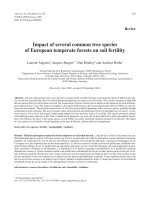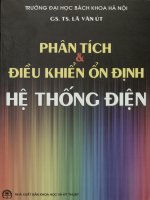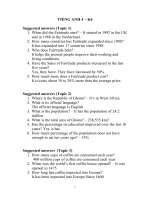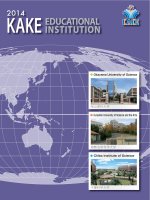Effect of INM on soil fertility, productivity and economics of cotton + greengram intercropping system in vertisols - Trường Đại học Công nghiệp Thực phẩm Tp. Hồ Chí Minh
Bạn đang xem bản rút gọn của tài liệu. Xem và tải ngay bản đầy đủ của tài liệu tại đây (204.01 KB, 6 trang )
<span class='text_page_counter'>(1)</span><div class='page_container' data-page=1>
<i><b>Int.J.Curr.Microbiol.App.Sci </b></i><b>(2017)</b><i><b> 6</b></i><b>(11): 3738-3743 </b>
3738
<b>Original Research Article </b>
<b>Effect of INM on Soil Fertility, Productivity and Economics of Cotton + </b>
<b>Greengram Intercropping System in Vertisols </b>
<b>Ashwini Chandel*, V.V. Gabhane, M.B. Nagdeve, A.B. Turkhede and R.S. Patode </b>
AICRP for Dryland Agriculture, Dr. Panjabrao Deshmukh Krishi Vidyapeeth,
Akola (MS) 444 104, Maharashtra, India
<i>*Corresponding author </i>
<i><b> </b></i> <i><b> </b></i><b>A B S T R A C T </b>
<i><b> </b></i>
<b>Introduction </b>
Cotton (G<i>ossypium </i>spp.) is an important cash
crop globally known as “king of fiber “and
play vital role in the economy of farmers as
well as the country and is popularly known as
“white gold”. India ranks first in area under
cotton in the world however, stands third in
production. It is a fiber crop originated in
India and belongs to Malvaceae family.
Among different species of cotton,
<i>Gossypium </i> <i>hirsutum</i> and <i>Gossypium </i>
<i>arborium</i> are commonly grown in
Maharashtra and used in textile industries for
manufacture of cloth. Besides this, it is also
used for several other purposes like making
threads and for mixing in other fibers.
India ranks first in the world having an area of
10.15 million ha with the production of 31.00
million bales. Maharashtra is one of the
leading cotton growing states in India having
41.92 lakh ha area under cotton cultivation
which is one third of country‟s area of cotton
cultivation with the production of 85 lakh
bales. The productivity of cotton in
<i>International Journal of Current Microbiology and Applied Sciences </i>
<i><b>ISSN: 2319-7706 Volume 6 Number 11 (2017) pp. 3738-3743 </b></i>
Journal homepage:
A long term field experiment to study the effect of INM on soil fertility and productivity of
cotton + greengram intercropping system in Vertisols was initiated during 1987-88 and the
present study was conducted during kharif 2015-16 at Research field of AICRP for
Dryland Agriculture, Dr. Panjabrao Deshmukh Krishi Vidyapeeth, Akola, Maharashtra.
The soil of the experimental site was moderately alkaline in reaction, low in available
nitrogen, medium in available phosphorus and high in available potassium. The eight
treatments comprised of control,100% RDF(50:25:00 NPK kg ha-1) through chemical
fertilizer,50% RDF through chemical fertilizer, 50% N through FYM/gliricidia, 50% N
through fertilizers + 50% N through FYM/gliricidia +100% P2O5 ha-1 fertilizers and 100%
N ha-1gliricidia + 100% P2O5ha-1 fertilizers in randomised block design with three
replications. The results after 29th cycle indicated that the use of FYM followed by
gliricidia green leaf manuring in conjunction with chemical fertilizers recorded higher
cotton and greengram yields with maximum monetary returns with improvement in soil
fertility. Hence, it is concluded that long term application of 50% N through
FYM/gliricidia + 50% N through inorganics + 100% P2O5 ha-1 to cotton+greengram (1:1)
intercropping system resulted in sustaining crop productivity and build up fertility status of
Vertisols under rainfed condition.
<b>K e y w o r d s </b>
INM, soil fertility,
Cotton + greengram
intercropping system,
Vertisols.
</div>
<span class='text_page_counter'>(2)</span><div class='page_container' data-page=2>
<i><b>Int.J.Curr.Microbiol.App.Sci </b></i><b>(2017)</b><i><b> 6</b></i><b>(11): 3738-3743 </b>
3739
Maharashtra is 345 kg lint per ha
(Anonymous, 2015).
Pulses play an important role in Indian
agriculture. Unique ability of biological
nitrogen fixation, deep root system,
mobilization of insoluble soil nutrients and
bringing qualitative changes in soil physical
properties make them known as “soil fertility
restorers”. Pulses are the main source of
protein for the bulk of population, which is
mostly vegetarian.
Greengram (<i>Vigna radiata</i>) is an excellent
source of high (25%) quality protein. The
whole or split grains are used as „dal‟ or made
into flour. The straw and husk are a fodder for
cattle. Grains are also used in many Indian
dishes. It belongs to leguminosae family and
is believed to be native of central Asia. It can
be raised on wide array of soil ranging from
red lateritic soils of south India to black
cotton soils of Maharashtra. It is one of the
thirteen food legumes grown in India and
third most important pulse crop of India after
chickpea and pigeonpea.
In India, the area under greengram is about
3.55 mha with production of 1.80 m tones and
productivity of 512 kg ha-1 whereas,
Maharashtra has about 4.08 lakhs ha area and
production is 2.38 lakh tones with
productivity of 531 kg ha-1. The area under
Vidarbha is 1.30 lakh ha, production 0.38lakh
tones with productivity of 344 kgha-1
(Anonymous, 2014).
Integrated plant nutrient management is an
intelligent use of optimum combination of
organic, inorganic and biological nutrient
sources in specific crop, cropping system and
climatic situation so as to achieve and sustain
optimum yield and to improve or maintain
soil physical, chemical and biological
properties. Integrated plant nutrient
management is beneficial to maintain soil
fertility, sustainable agricultural production
and increase availability of nutrients from all
resources and minimizing loss of nutrients.
<b>Materials and Methods </b>
With the aim of maintenance of soil fertility
and plant nutrient supply to an optimum level
for sustaining the desired crop productivity
through optimization of benefit from organic
plant nutrient sources available at farm level
in the region, a fixed frame plot experiment
with the combinations of organic and
inorganic nutrient sources is being conducted
in cotton + greengram intercropping system
on Vertisols since 1987-88.The present study
was carried out during 2015-16(29th cycle).
<b>Treatment details</b>
T1 - Control
T2 - 100% N + 100% P2O5 ha-1 fertilizers
T3 - 50% N + 50% P2O5 ha-1 fertilizers
T4 - 50% N ha-1gliricidia
T5 - 50% N ha-1 FYM
T6 - 50% N Fertilizers + 50% N
gliricidia+100% P2O5 ha-1 fertilizers
T7 - 50% N Fertilizers + 50% N ha-1 FYM +
100% P2O5 ha-1 fertilizers
The soil samples were collected after harvest
of cotton crop and were analyzed for available
nutrients (N, P & K) as per standard methods.
<b>Results and Discussion </b>
<b>Soil fertility</b>
</div>
<span class='text_page_counter'>(3)</span><div class='page_container' data-page=3>
<i><b>Int.J.Curr.Microbiol.App.Sci </b></i><b>(2017)</b><i><b> 6</b></i><b>(11): 3738-3743 </b>
3740
treatments. The available N in soil varied
from 209.1 to257.2kg ha-1. The higher
available N (257.2kg ha-1) was observed in
treatmentT7 receiving 50% N fertilizers +
50% N ha-1 FYM + 100% P2O5 ha-1 fertilizers
and it was found to be at par with treatment
T6 i.e.50% N fertilizers + 50% N gliricidia
+100% P2O5 ha-1 fertilizers. The lower value
of N was found in treatment T1 i.e. control.
The higher value of available N over the
initial value might be due to nitrogen fixation
by greengram crop. The favourable soil
conditions under FYM addition might have
helped in mineralization of soil N leading to
build up of higher available N Similar results
were also given by Goud and Konde (2007),
Yadav <i>et al.,</i> (2010) and Vidyavathi <i>et al.,</i>
(2012).
It is evident from the data in Table 1 that
available P content of soil varied significantly
and it ranged from 10.3 to 15.8 kg ha
-1
indicating that the soil was medium to high
in available phosphorus content. The highest
(15.8 kg ha-1) available P was found in
treatmentT7 receiving 50% N fertilizers +
50% N ha-1 FYM + 100% P2O5 ha-1 fertilizers
and it was found to be at par with the
treatments T6 i.e.50% N fertilizers + 50% N
gliricidia +100% P2O5 ha-1 fertilizers and T8
i.e.100% N ha-1gliricidia + 100% P2O5 ha-1
fertilizers. The lower value of P was found in
treatment T1 i.e. control. The increase in
available phosphorus status is due to use of
FYM, being direct source of phosphorus and
it might have also solubilized the native
phosphorus in the soil through release of
various organic acids which had chelating
effect, that reduced phosphorus fixation
The higher values of available phosphorus in
treatment T7 and T6may be due to addition of
phosphorus through FYM/ gliricidia in soil.
Similar results were recorded by Bharambe
and Tomar (2004), Goud and Konde (2007)
and Vidyavathi <i>et al.,</i> (2012).
The data (Table 1) on available K content of
soil varied significantly from 280.0 to
362.1kg ha-1 indicating that the soil was high
to very high in available K content. Data
indicated that highest available K content
(362.1kg ha-1) was observed in treatmentT7
receiving 50% N fertilizers + 50% N ha-1
FYM + 100% P2O5 ha-1 fertilizers and T7was
found to be at par with the T6 i.e.50% N
fertilizers + 50% N gliricidia +100% P2O5 ha
-1
fertilizers and T8 i.e.100% N ha-1gliricidia +
100% P2O5 ha-1 fertilizers.
The higher values of available potassium in
treatments T6, T7 and T8 may be due to the
application of potassium through gliricidia
green leaf manuring might be due to the fact
that gliricidia leaves contains higher amount
of K and it is deposited in the soil and due to
applied K through gliricidia green leaf
manure, the solubilizing action of certain
organic acids produced during decomposition
and it results in greater capacity to hold K in
the available form.
Similar results were observed by Hadvani and
Gundalia (2003), Goud and Konde (2007) and
Vidyavathi <i>et al.,</i> (2012).
<b>Yield of cotton and greengram </b>
The data pertaining to seed cotton and stalk
yield and greengram grain and straw yield in
intercropping system under long term effect
of organics and fertilizers is presented in
Table 2. The seed cotton yield as well as
greengram yield was found statistically
significant under different treatments during
the year 2015-16.
<b>Yield of cotton </b>
</div>
<span class='text_page_counter'>(4)</span><div class='page_container' data-page=4>
<i><b>Int.J.Curr.Microbiol.App.Sci </b></i><b>(2017)</b><i><b> 6</b></i><b>(11): 3738-3743 </b>
3741
(T7) followed by application of 50% N
through gliricidia+50% N through
inorganics+ 100% P2O5 ha-1 fertilizers (T6)
which were found to be on par with each
other. The lower seed cotton yield (648.0kg
ha-1) was recorded in control (T1) treatment.
The significantly highest cotton stalk yield
(2207.3kg ha-1) was recorded with the
application of 50% N through FYM +50% N
through inorganics+100% P2O5 ha-1 fertilizers
(T7) followed by application of 50% N
throughgliricidia+50% N through inorganics+
100% P2O5 ha-1 fertilizers (T6) which were
found to be on par with each other. The
lowest stalk yield (1608.7kg ha-1) was
recorded in the treatment T1 control.
<b>Table.1 </b>Effect of long term INM on soil fertility
<b>Table.2 </b>Yield of cotton + greengram under (1:1) intercropping system
<b>Treatments </b> <b>Available Nutrients(kg ha-1) </b>
N P K
T
1 Control 209.1 10.3 280.0
T
2 100% N + 100% P
2O5 ha
-1
fertilizers 240.4 13.3 317.3
T
3 50% N + 50% P
2O5 ha
-1
fertilizers 236.6 12.5 313.6
T
4 50% N ha
-1
gliricidia 234.2 11.3 324.8
T
5 50% N ha
-1
FYM 238.3 12.2 326.7
T
6 50% N fertilizers + 50% N gliricidia +100% P
2O5 ha
-1
fertilizers 250.9 15.1 358.4
T
7 50% N fertilizers + 50% N ha
-1
FYM + 100% P
2O5 ha
-1
fertilizers 257.2 15.8 362.1
T
8 100% N ha
-1
gliricidia + 100% P
2O5 ha
-1
fertilizers 242.5 14.9 339.7
SE (m) ± 6.4 0.6 11.7
CD at 5% 19.0 1.9 34.6
<b>Treatments </b> <b>Cotton yield (kg ha-1) </b> <b>Greengram yield (kg ha-1) </b>
Seed cotton Stalk Grain Straw
T
1 Control 648.0 1608.7 245.4 179.0
T
2 100% N + 100% P
2O5 ha
-1
fertilizers 968.9 2132.4 344.8 247.2
T
3 50% N + 50% P
2O5 ha
-1
fertilizers 895.2 1833.1 325.6 209.1
T
4 50% N ha
-1
gliricidia 810.7 1683.5 309.8 194.0
T
5 50% N ha
-1
FYM 827.5 1646.1 321.0 198.7
T
6 50% N fertilizers + 50% N gliricidia +100% P
2O5 ha
-1
fertilizers 1017.6 2169.8 413.4 260.3
T
7 50% N fertilizers + 50% N ha
-1
FYM + 100% P
2O5 ha
-1
fertilizers
1179.9 2207.3 448.4 264.0
T
8 100% N ha
-1
gliricidia + 100% P
2O5 ha
-1
fertilizers 987.7 1795.7 357.5 231.2
SE (m) ± 63.1 112.6 23.4 13.3
</div>
<span class='text_page_counter'>(5)</span><div class='page_container' data-page=5>
<i><b>Int.J.Curr.Microbiol.App.Sci </b></i><b>(2017)</b><i><b> 6</b></i><b>(11): 3738-3743 </b>
3742
<b>Table.3 </b>Effect of long term INM on economics of cotton + greengram (1:1) intercropping system
Higher cotton yield with conjunctive
application of FYM, gliricidia green leaf
manure along with chemical fertilizers may be
due to balanced supply of nutrients to the crops
throughout the crop growth period.
Green leaf manure undergo decomposition
during which series of nutrient transformation
takes place which helps in their higher
availability to the crops and higher uptake of
nutrients by the crops will result in higher yield.
Similar results were also reported by Kamble <i>et </i>
<i>al.,</i> (2009), Sonawane <i>et al.,</i> (2009), Mankar
and Nawlakhe (2009) and Sonune <i>et al.,</i> (2012).
<b>Yield of greengram </b>
The significantly highest grain yield (448.4kg
ha-1) of greengram was recorded by the
treatment T7 receiving 50% N through
fertilizers + 50% N ha-1 through FYM + 100%
P2O5 ha-1 through fertilizers and was found to
be on par with application of 50% N fertilizers
+ 50% N gliricidia +100% P2O5 ha-1
fertilizers(T6).
The highest straw yield (264.0kg ha-1) of
greengram was recorded by the treatment T7
receiving 50% N through fertilizers + 50% N
ha-1 through FYM + 100% P2O5 ha-1 through
fertilizers and was found to be on par with
application 50% N fertilizers + 50% N gliricidia
+100% P2O5 ha-1 fertilizers(T6).
Similar results were also reported by Yadav <i>et </i>
<i>al.,</i> (2007), Mankar and Nawlakhe (2009) and
Choudhari <i>et al.,</i> (2011).
<b>Economics of cotton + greengram (1:1) </b>
<b>intercropping system </b>
The data on effect of long term IPNS on
economics of cotton + greengram (1:1)
intercropping system is presented in Table 3.
The data indicate that the highest gross
monetary returns(GMR) of 93490.16/- Rs ha-1
was obtained with application of 50% N
fertilizers + 50% N ha-1 FYM + 100% P2O5 ha-1
fertilizers(T7), followed by 8281.32 Rs ha-1 with
application of 50% N fertilizers + 50% N
gliricidia +100% P2O5 ha-1 fertilizers(T6), which
were found to be on par with each other.
However, the highest net monetary
returns(NMR) of 56475.16/- Rs ha-1 was
obtained with 50% N fertilizers + 50% N ha-1
FYM + 100% P2O5 ha-1 fertilizers(T7), followed
by 51117.32 Rs ha-1 with application of 50% N
fertilizers + 50% N gliriicidia +100% P2O5 ha-1
fertilizers(T6), which were found to be on par
with each other.
Treatment GMR
(Rs ha-1)
NMR
(Rs ha-1)
B:C ratio
T1 Control 51675.69 28873.69 2.27
T2 100% N + 100% P2O5 ha-1 fertilizers 75407.89 46161.89 2.58
T3 50% N + 50% P2O5 ha-1 fertilizers 69999.79 43125.79 2.60
T4 50% N ha-1gliricidia 64524.21 38643.21 2.49
T5 50% N ha-1 FYM 66208.75 35177.75 2.13
T6 50% N fertilizers + 50% N gliricidia +100% P2O5 ha-1
fertilizers
82813.32 51117.32 2.61
T7 50% N fertilizers + 50% N ha-1 FYM + 100% P2O5
ha-1 fertilizers
93490.16 56475.16 2.53
T8 100% N ha-1gliricidia + 100% P2O5 ha-1 fertilizers 77102.88 48417.88 2.69
SE (m) ± 3826.127 3826.127 -
</div>
<span class='text_page_counter'>(6)</span><div class='page_container' data-page=6>
<i><b>Int.J.Curr.Microbiol.App.Sci </b></i><b>(2017)</b><i><b> 6</b></i><b>(11): 3738-3743 </b>
3743
The B:C ratio was also found to be
maximum(2.61) with application of 50% N
fertilizers + 50% N gliricidia +100% P2O5 ha-1
fertilizers(T6).The higher NMR and B:C ratio
obtained with application of 50% N through
fertilizers + 50% N through gliricidia+100%
P2O5 ha-1 through fertilizers(T6) as compared to
50% N through fertilizers + 50% N ha-1 through
FYM + 100% P2O5 ha-1 through fertilizers(T7)
may be due to higher cost of FYM as compared
to gliricidia.
The results after 29th cycle indicated that the use
of FYM followed by gliricidia green leaf
manuring in conjunction with chemical
fertilizers recorded higher nutrient uptake,
cotton and greengram yields with maximum
monetary returns and improvement in soil
fertility. Hence, it is concluded that long term
INM of 50% N through FYM/gliricidia + 50%
N through inorganics + 100% P2O5 ha-1 to
cotton + greengram (1:1) intercropping system
resulted in sustaining crop productivity and
build up fertility status of Vertisols under
rainfed condition.
<b>References </b>
Anonymous, 2014. Districtwise general
statistical information of agriculture
department (MS) part 2, page 4.
Anonymous, 2015.Current cotton scenario,
Cotton corporation of India.
Bharambe, A.P. and Anurag Tomar, 2004.
Effect of integrated nutrient management
on soil and crop production and nutrient
uptake of rice grown on Vertisol. PKV
Res. J. 28 (1): 53-57.
Choudhari H.R., Sharma O.P, Yadav L.R. and
Choudhari G.L. 2011. Effect of organic
sources and chemical fertilizers on
productivity of mungbean. Journal of
Food Legumes 24(4): 324-326.
Goud, V. V. and Konde, N. M. 2007. Effect of
integrated use of inorganic fertilizers and
FYM on fertility of a Vertisol, PKV. Res.
J. 31(1): 77- 80.
Hadvani, G.J. and Gundalia J.D.2003. Direct
effect of potassium on summer
groundnut and its residual effect on
pearlmillet grown in medium black
calcareous soil. 19: 93-98.
Kamble, Anand S., Palled Y. B. and
Channagoudar R. F. 2009. Response of
hybrid cotton (DHH-11) to in situ green
manuring and nitrogen levels in northern
transitional tract of Karnataka.
International J. Agril. Sci. 5(2): 543-546.
Mankar, D. D. and Nawlakhe S. M.2009. Yield
attributes and yield of cotton (main crop
and greengram (intercrop) and quality of
cotton-greengram intercropping. J. Soils
and Crops, 19(2): 315-319.
Sonune, B.A., Gabhane V.V., Rewatkar S.S.
and Sawangikar M. S.2012. Productivity
of Rainfed Cotton and Soil Health as
Influenced by Tillage and Integrated
Nutrient Management in Vertisol under
Semi-Arid Agro- Ecosystem of
Maharashtra. Indian J. Dryland Agric.
Res. and Dev. 27(1):10-17.
Vidyavathi, G. Dasog, G.S., Babalad H. B.,
Hebsur N. S., Gali S. K., Patil S. G and
Alagawadi A. R. 2012. Nutrient status of
soil under different nutrient and crop
management practices. Karnataka J.
Agric. Sci., 25(2): 193-198.
Yadav, P.C., Sadhu A.C., Swarnkar P. K. and
Patel M. R. 2010. Effect of integrated
nitrogen management on forage yield of
multicut sorghum, available nitrogen and
microbial count in the soil. J. Indian Soc.
Soil Sci. 58(3): 303-308.
<b>How to cite this article: </b>
Ashwini Chandel, V.V. Gabhane, M.B. Nagdeve, A.B. Turkhede and Patode, R.S. 2017. Effect of
INM on Soil Fertility, Productivity and Economics of Cotton + Greengram Intercropping System in
Vertisols. <i>Int.J.Curr.Microbiol.App.Sci.</i> 6(11): 3738-3743.
</div>
<!--links-->
Ôn tập triết học cao học trường đại học nông nghiệp hà nội
- 42
- 382
- 0








